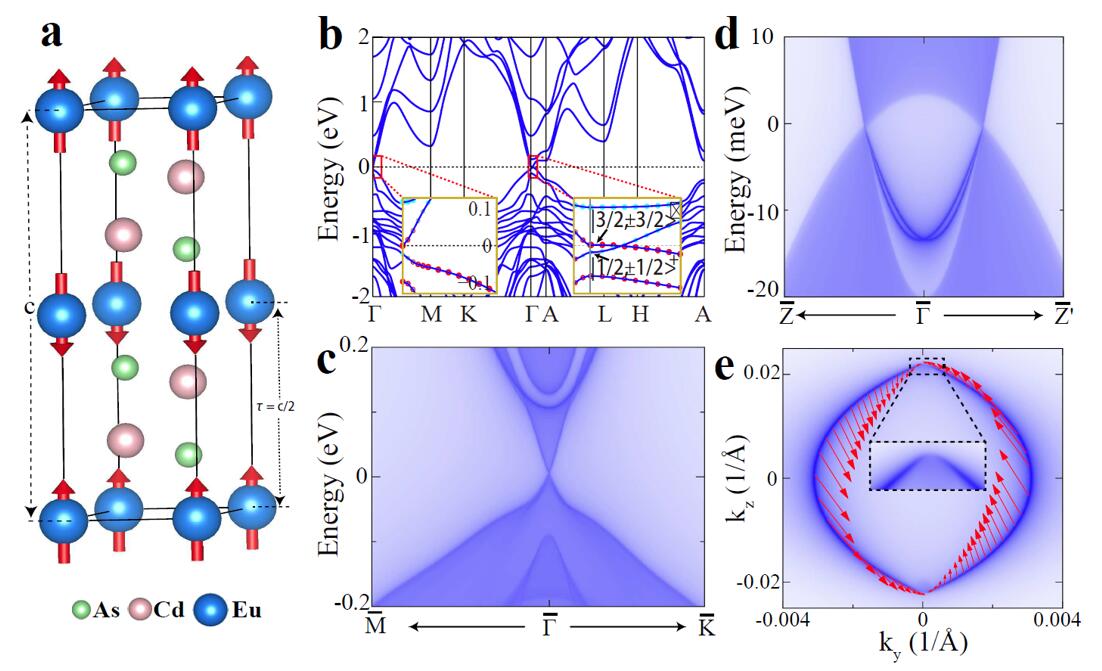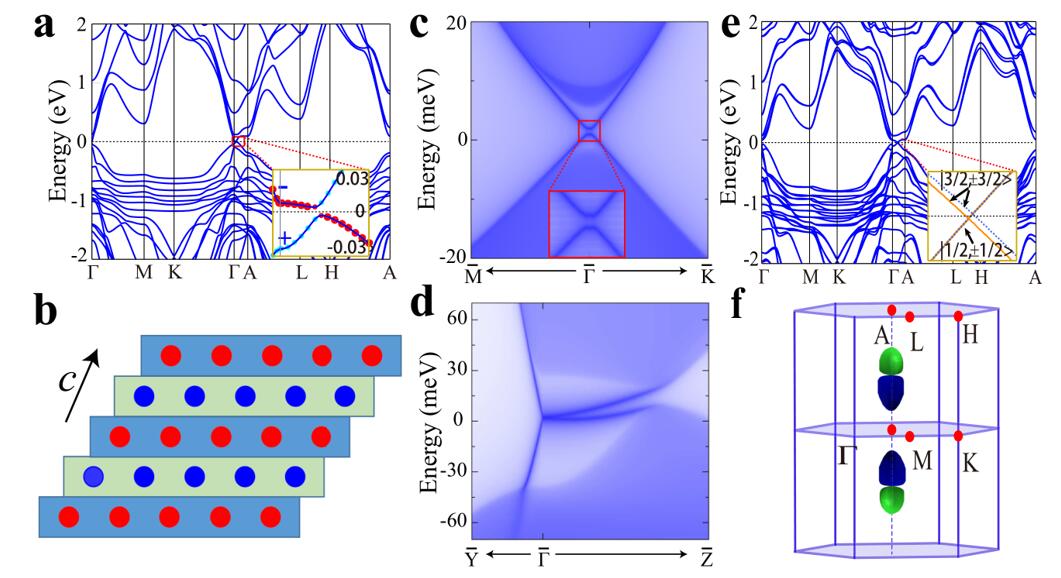
FIG. 1: (a) Crystal structure of the interlayer AFM EuCd2As2. (b) Band structures of the interlayer AFM EuCd2As2. (c), (d) Surface states of the interlayer AFM EuCd2As2 on the (001) and (100) faces, respectively. (e) The Fermi arcs and their spin textures on the (100) face of the interlayer AFM EuCd2As2.

FIG. 2: (a) Band structures of the interlayer AFM EuCd2As2 in the case of C3z breaking. (b) Schematic of the AFM TI by stacking the 2D Chern insulators along the c-axis, where the red and blue balls represent the up spin layers (Chern number C=1) and down spin layers (C=-1), respectively. (c), (d) Surface states of the AFM TI on the (001) and (100) faces, respectively. (e), (f) Band structures and Fermi surfaces in the AFM triple point semimetal phase by the inversion symmetry P breaking.
( PHYSICAL REVIEW B 98, 201116(R) (2018), DOI:10.1103/PhysRevB.98.201116 )
Background
Analogues of the elementary particles, massless Dirac fermions in condensed matter have received extensive attention for both scientific interest and technological applications. The discovery of new type of Dirac Semimetal (DSM) is one of the most exciting directions in this field. Until now, most studied DSMs are the nonmagnetic materials defined in the space groups. Considering the richness of the magnetic materials and the magnetic space groups (MSGs), it is valuable to propose a general classification of the 3D DSMs in the MSGs. More new type of magnetic DSMs and the other exotic magnetic topological states are also appreciated.
What we discover?
In a recent work, Gang Xuet al. have generalized the concept of DSM to the MSGs, and found a new kind of DSMs in type IV MSGs, which can be protected by the inversion symmetry, non-symmorphic time-reversal symmetry and suitable rotation symmetry, and exhibits a totally different topological phase diagram.
By performing the density functional theory calculations, they proposed the interlayer AFM EuCd2As2 as a promising candidate with only one pair of Dirac points at the Fermi level, as shown in Fig. 1. Moreover, many exotic topological states, such as the triple point semimetal (see Fig. 2(e), (f)) and the AFM topological insulator (see Fig. 2(a)) holding of the half-quantum Hall Effect (Fig. 2(c)), can be derived from such AFM DSMs by breaking certain symmetry, providing an ideal platform to study topological phase transitions.
Why is this important?
This work extends the range of DSMs, and provides a reliable route to find DSMs in magnetic materials. The proposed interlayer AFM EuCd2As2 provides an ideal platform to study the exotic properties of the AFM topological states and the AFM topological phase transition. Guided by our work, many experimental verification of the feasible DSM in the type IV MSGs has been carried out by many experimental groups.
Who did the research?
Guiyuan Hua1,*,Simin Nie2,*,Zhida Song3,†,Rui Yu4,‡,Gang Xu1,§,and Kailun Yao1
1Wuhan National High Magnetic Field Center & School of Physics, Huazhong University of Science and Technology, Wuhan 430074, China
2Department of Materials Science and Engineering, Stanford University, Stanford, California 94305, USA
3Beijing National Research Center for Condensed Matter Physics, and Institute of Physics, Chinese Academy of Sciences, Beijing 100190, China
4School of Physics and Technology, Wuhan University, Wuhan 430072, China
Funding
This work is supported by the Ministry of Science and Technology of China (2018YFA0307000); G.X. and R.Y. are supported by the National Thousand-Young Talents Program and the National Natural Science Foundation of China (11874022); S.N. is supported by Stanford Energy 3.0.
